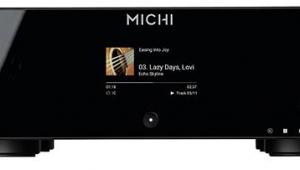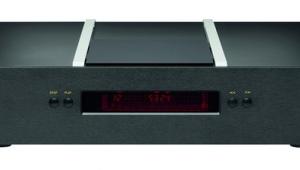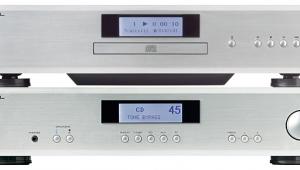Nagra Audio Cdp (£8500)
Predisposed as I am toward Nagra, the long-awaited CD player presents a quandary: Although this brand has a hold on my heart – I would gladly live forever with their valve electronics – I am increasingly distressed by the ever-spiralling pricing of high-end audio. Nagra, being both Swiss and high-end, is as guilty as any of widening the chasm between reality and sanity. £8500 for any CD player is to take the mickey. Yet something so ‘right’ about the wee Nagra CDP almost makes me want to forgive the pricing.
TWO REASONS TO BUY
Offensive price or not, the CDP looks almost under-priced when compared to other high-end CD players, so it evens out, and for two reasons. First is the sheer joy of owning a Nagra product. Second? It sounds wonderful.
Because it’s designed to operate with a Nagra preamp [see boxout, below], it shares the same dimensions as its PL-L and PL-P and is therefore smaller than the 430mm norm at 310 x 77 x 255mm (whd). This in itself is a boon to those who are not impressed by sheer size. Machined from a block of solid aluminium, it still weighs 4kg, attesting to filled innards. And that’s with the 12V DC power supply relegated to the outside, which better isolates the unit from the mains.
Like, I believe, certain older Meridian players, the CDP is a front-loader with the ‘playback module mounted securely in the CD drawer’. This ensures greater stability, the disc held in place by a magnetic puck. And Nagra, its conservatism no doubt leading to its protracted entry into CD player manufacture, eschews upsampling and other digital prestidigitation.
ROTARY CLUB
Nagra has its own world view, so the controls are not intuitive to anyone other than a veteran Nagra user. I mean, how many CD players have rotary transport controls? Or a special position of the knob for remote control operation? A teensy toggle switch to open and close the drawer? Some might argue that it’s worth the extra money to have such a different experience controlling a CD player – like buying a car just because it has a starter button.
Nagra positioned the back-lit LCD display on the front of the transport tray, while the rest of the fascia needs only to accommodate the traditional Nagra rotary control for transport functions and two toggles: one for dimming the display and one for opening and closing the drawer. The back provides selection of one pair each of single-ended phono and balanced XLR analogue outputs, plus coaxial S/PDIF, AES/EBU and Toslink S/PDIF digital outputs. Using Yter’s new XLR wires, I fed the CDP to the McIntosh C2200 preamp, MC2102 and Quad II-eighty power amps; speakers included Sonus faber Cremona M and Guarneri, and Rogers LS3/5A.
SHEER SEDUCTION
Forgetting the reasons I wanted this player even before switching it on – the construction, the feel of the controls, the Nagra badge – and trying hard not to be seduced by the operation of the tray, I knew this player would hit me as hard as Liv Tyler in a sheer negligee. Sometimes, you just sense what’s going to happen. It only took the glorious, open, smooth and enveloping sound of Mofi’s new gold CD of Marc Cohn’s eponymous debut to demonstrate the CDP’s worthiness as part of the Nagra family.
In direct contrast to Chord’s impressive but aloof Red Reference, the CDP was as lush and natural as my beloved Marantz CD-12/DA-12. Cohn’s delivery, especially on his signature tune, ‘Walking in Memphis’, was as convincingly present in my room as ever I’ve heard it. With LS3/5As or Cremona Ms carefully focused, the presence was eerily palpable. It made me want to grab the first schmuck I could find with an iPod to show him what he’s missing.
Discs were flying everywhere: power pop from the Raspberries was punchy and tight, live Hendrix (from Monterey) had that distinctive stretched-string whine nailed down. ‘The Wind Cries Mary’ drew a lump to the throat, while a mere 60 seconds’ worth of ‘Like A Rolling Stone’ convinced me that Hendrix’s take is the best Dylan cover ever. The attack of the plucking, complementing his distinctive vocals, the sheer power of his rhythm section – 40 years old the recordings may be, but the Nagra delivered them as fresh as this morning’s croissant.
THE REAL THING
It got down to one thing: whether the measurements identify it or not, something about the Nagra grabs your attention. The soon-to-be-overused word ‘authenticity’ applies here in its original rather than commercial sense: there’s simply as little artifice as can possibly remain when using a digital source. Which brings us to both Nagra’s late entry into CD player production, and the recent arrival of other costly machines.
Clearly, CD’s days are numbered. If you doubt for a minute that a hugely successful format can be flushed down the toilet in record time, just look how quickly VHS, cassettes and film photography were relegated to the trash bin. CD, though, retains a foothold in the PC world, and lots of people who steal music still burn CDs instead of simply downloading to memory cards. But the end will arrive sooner than you think.
What players like the Nagra demonstrate is that CD ‘done right’ doesn’t ‘suck’ in the way that its detractors argued long after the first-generation machines were forgotten. Nagra, though, took its time, emulating Quad’s and McIntosh’s cautious entries into CD manufacture, but dragging it out to the extreme. It waited even longer than Peter Walker took to produce the ESL-63. But the CDP was worth the wait.
If, that is, you have a huge library of CDs you have no intention of replacing, and the urge to buy what might be the last player you’ll ever need.
VERDICT
Minimalist to a fault, but with operational behaviour that makes gadget-heads swoon (once that tray slides out, you’re hooked), Nagra’s CDP is so achingly desirable that it makes the iPhone look like a plastic toy. It sounds terrific, it’s a joy to use, its operational quirks, like a manual setting to use the remote, are endearing rather than annoying. If you have the money, just go for it.
Originally published in the January 2008 issue

























































